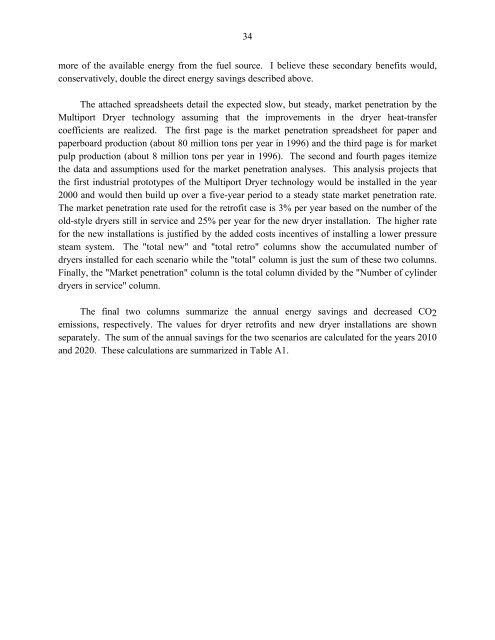final report on the multiport dryer - Argonne National Laboratory
final report on the multiport dryer - Argonne National Laboratory
final report on the multiport dryer - Argonne National Laboratory
You also want an ePaper? Increase the reach of your titles
YUMPU automatically turns print PDFs into web optimized ePapers that Google loves.
34more of <strong>the</strong> available energy from <strong>the</strong> fuel source. I believe <strong>the</strong>se sec<strong>on</strong>dary benefits would,c<strong>on</strong>servatively, double <strong>the</strong> direct energy savings described above.The attached spreadsheets detail <strong>the</strong> expected slow, but steady, market penetrati<strong>on</strong> by <strong>the</strong>Multiport Dryer technology assuming that <strong>the</strong> improvements in <strong>the</strong> <strong>dryer</strong> heat-transfercoefficients are realized. The first page is <strong>the</strong> market penetrati<strong>on</strong> spreadsheet for paper andpaperboard producti<strong>on</strong> (about 80 milli<strong>on</strong> t<strong>on</strong>s per year in 1996) and <strong>the</strong> third page is for marketpulp producti<strong>on</strong> (about 8 milli<strong>on</strong> t<strong>on</strong>s per year in 1996). The sec<strong>on</strong>d and fourth pages itemize<strong>the</strong> data and assumpti<strong>on</strong>s used for <strong>the</strong> market penetrati<strong>on</strong> analyses. This analysis projects that<strong>the</strong> first industrial prototypes of <strong>the</strong> Multiport Dryer technology would be installed in <strong>the</strong> year2000 and would <strong>the</strong>n build up over a five-year period to a steady state market penetrati<strong>on</strong> rate.The market penetrati<strong>on</strong> rate used for <strong>the</strong> retrofit case is 3% per year based <strong>on</strong> <strong>the</strong> number of <strong>the</strong>old-style <strong>dryer</strong>s still in service and 25% per year for <strong>the</strong> new <strong>dryer</strong> installati<strong>on</strong>. The higher ratefor <strong>the</strong> new installati<strong>on</strong>s is justified by <strong>the</strong> added costs incentives of installing a lower pressuresteam system. The "total new" and "total retro" columns show <strong>the</strong> accumulated number of<strong>dryer</strong>s installed for each scenario while <strong>the</strong> "total" column is just <strong>the</strong> sum of <strong>the</strong>se two columns.Finally, <strong>the</strong> "Market penetrati<strong>on</strong>" column is <strong>the</strong> total column divided by <strong>the</strong> "Number of cylinder<strong>dryer</strong>s in service" column.The <str<strong>on</strong>g>final</str<strong>on</strong>g> two columns summarize <strong>the</strong> annual energy savings and decreased CO2emissi<strong>on</strong>s, respectively. The values for <strong>dryer</strong> retrofits and new <strong>dryer</strong> installati<strong>on</strong>s are shownseparately. The sum of <strong>the</strong> annual savings for <strong>the</strong> two scenarios are calculated for <strong>the</strong> years 2010and 2020. These calculati<strong>on</strong>s are summarized in Table A1.
















